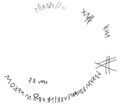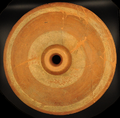VB·3.2: Difference between revisions
No edit summary |
No edit summary |
||
| (One intermediate revision by the same user not shown) | |||
| Line 1: | Line 1: | ||
{{inscription | {{inscription | ||
|reading= | |reading=inou : ea | ||
|reading_lepontic={{c|A}}{{c|E}}{{c|separator}}{{c|U| | |reading_lepontic={{c|A}}{{c|E}}{{c|separator}}{{c|U|U12}}{{c|O|O3}}{{c|N}}{{c|I}} | ||
|reading_variant={{ | |reading_variant={{w|mou}} : {{w|ea}}<br>{{c||A}}{{c||E}}{{c||separator}}{{c||U12}}{{c||O3}}{{c|M}} | ||
|direction=sinistroverse | |direction=sinistroverse | ||
|letter_height_min=0 | |letter_height_min=0.4 cm | ||
|letter_height_max=1 cm | |||
|letter_number_min=5 | |letter_number_min=5 | ||
|letter_number_max=6 | |letter_number_max=6 | ||
| Line 26: | Line 27: | ||
|source_detail=Morandi 2004: 550–552 no. 48 B1 | |source_detail=Morandi 2004: 550–552 no. 48 B1 | ||
|checklevel=2 | |checklevel=2 | ||
|problem= | |problem=mo weg? literature | ||
|disambiguation=VB·3 | |disambiguation=VB·3 | ||
}} | }} | ||
==Commentary== | ==Commentary== | ||
First published in | First published in {{bib|Bianchetti 1895}}: 69 f. (no. 21). Examined for LexLep on 20<sup>th</sup> April 2024. | ||
Images in {{bib|Lejeune 1987}}: 508, fig. 6 (drawing), {{bib|Solinas 1995}}: tav. LXXIa (photo), {{bib|Morandi 2004}}: 566, fig. 12.48 (drawing). | Images in {{bib|Lejeune 1987}}: 508, fig. 6 (drawing), {{bib|Solinas 1995}}: tav. LXXIa (photo), {{bib|Morandi 2004}}: 566, fig. 12.48 (drawing). | ||
{{bib|Kretschmer 1905}}: 99, no. 21 | Inscribed above the sequence {{w||uinom}} of [[VB·3.1]], near the innermost of the white bands (length 2.7 cm). The distance between upsilon and epsilon is larger than those between the other letters, and two adjacent round marks are situated where a single-dot separator might be expected; the marks themselves, however, look much like other spots of surface damage and are not evidently intentional. Bianchetti read a single sequence ''inouea'' (also {{bib|Kretschmer 1905}}: 99, no. 21, {{bib|Rhŷs 1913}}: 62, no. 20 (a)); the mark was considered relevant by {{bib|Whatmough 1933}}: 111–113, no. 304 (b) and {{bib|Pisani 1964}}: 286 f., no. 124 (b), the latter considering the inscription to form a sentence together with the other three short inscriptions (''etninou.ealutou:iutuni:'', see also {{bib|Lejeune 1971}}: 74, n. 259). {{bib|Tibiletti Bruno 1978}}: 144, 146 (also {{bib|Tibiletti Bruno 1981|1981}}: 162–164, no. 10) proposed to read the initial group of scratches as a very uneven mu ''mou.ea'', including a faint oblique scratch crossing iota and nu (see also {{bib|Lejeune 1987}}: 497, {{bib|Morandi 2004}}: 550–552 no. 48 B1). Undecided, but including the separator, {{bib|Solinas 1995}}: 375, no. 128 4. | ||
We consider the scratch which is supposed to form Tibiletti's ramshackle mu unintentional, and the separator at least doubtful – clear separators in the inscriptions on the flask consist of at least two vertcally arranged dots, though the distance between upsilon and epsilon does indicate two separate sequences. Cf. specifically [[VB·3.3]] for a short inscription with internal separation, also with a first part which ends in ''ou''. The interpretation is unclear in any case, as no reading variant represents a linguistically plausible form. | |||
See also {{bib|Giussani 1902}}: 55 f., '''{{bib|Piana Agostinetti 1972}}: 272, no. 12, tav. XXXI.12''', '''{{bib|Piana Agostinetti 1997–1999}} II: 57, in IV {{bib|Morandi 1999b}}: 308–312, no. 4'''. | See also {{bib|Giussani 1902}}: 55 f., '''{{bib|Piana Agostinetti 1972}}: 272, no. 12, tav. XXXI.12''', '''{{bib|Piana Agostinetti 1997–1999}} II: 57, in IV {{bib|Morandi 1999b}}: 308–312, no. 4'''. | ||
<p style="text-align:right;>[[User:Corinna Salomon|Corinna Salomon]]</p> | |||
{{bibliography}} | {{bibliography}} | ||
Revision as of 20:56, 18 June 2024
| Inscription | |
|---|---|
| Reading in transliteration: | inou : ea |
| Reading in original script: | |
| Variant reading: | mou : ea |
|
| |
| Object: | VB·3 Ornavasso (bottle) (Inscriptions: VB·3.1, VB·3.2, VB·3.3, VB·3.4, VB·3.5) |
| Position: | shoulder, outside |
| Orientation: | 0° |
| Direction of writing: | sinistroverse |
| Script: | North Italic script (Lepontic alphabet) |
| Letter height: | 0.4–1 cm0.157 in <br />0.394 in <br /> |
| Number of letters: | 5–6 |
| Number of words: | 2 |
| Number of lines: | 1 |
| Workmanship: | scratched after firing |
| Condition: | complete |
|
| |
| Archaeological culture: | La Tène D 1 [from object] |
| Date of inscription: | end of 2nd/beginning of 1st c. BC [from object] |
|
| |
| Type: | unknown |
| Language: | unknown |
| Meaning: | unknown |
|
| |
| Alternative sigla: | Whatmough 1933 (PID): 304 a Tibiletti Bruno 1981: 10 Solinas 1995: 128 4 Morandi 2004: 48 B1 |
|
| |
| Sources: | Morandi 2004: 550–552 no. 48 B1 |
Images
|
| ||||
Commentary
First published in Bianchetti 1895: 69 f. (no. 21). Examined for LexLep on 20th April 2024.
Images in Lejeune 1987: 508, fig. 6 (drawing), Solinas 1995: tav. LXXIa (photo), Morandi 2004: 566, fig. 12.48 (drawing).
Inscribed above the sequence uinom of VB·3.1, near the innermost of the white bands (length 2.7 cm). The distance between upsilon and epsilon is larger than those between the other letters, and two adjacent round marks are situated where a single-dot separator might be expected; the marks themselves, however, look much like other spots of surface damage and are not evidently intentional. Bianchetti read a single sequence inouea (also Kretschmer 1905: 99, no. 21, Rhŷs 1913: 62, no. 20 (a)); the mark was considered relevant by Whatmough 1933: 111–113, no. 304 (b) and Pisani 1964: 286 f., no. 124 (b), the latter considering the inscription to form a sentence together with the other three short inscriptions (etninou.ealutou:iutuni:, see also Lejeune 1971: 74, n. 259). Tibiletti Bruno 1978: 144, 146 (also 1981: 162–164, no. 10) proposed to read the initial group of scratches as a very uneven mu mou.ea, including a faint oblique scratch crossing iota and nu (see also Lejeune 1987: 497, Morandi 2004: 550–552 no. 48 B1). Undecided, but including the separator, Solinas 1995: 375, no. 128 4.
We consider the scratch which is supposed to form Tibiletti's ramshackle mu unintentional, and the separator at least doubtful – clear separators in the inscriptions on the flask consist of at least two vertcally arranged dots, though the distance between upsilon and epsilon does indicate two separate sequences. Cf. specifically VB·3.3 for a short inscription with internal separation, also with a first part which ends in ou. The interpretation is unclear in any case, as no reading variant represents a linguistically plausible form.
See also Giussani 1902: 55 f., Piana Agostinetti 1972: 272, no. 12, tav. XXXI.12, Piana Agostinetti 1997–1999 II: 57, in IV Morandi 1999b: 308–312, no. 4.
Bibliography
| Bianchetti 1895 | Enrico Bianchetti, I sepolcreti di Ornavasso [= Atti della Società di Archeologia e Belle Arti della provincia di Torino 6], Torino: Paravia 1895. |
|---|---|
| Giussani 1902 | A[ntonio] Giussani, "L' iscrizione nord-etrusca di Tesserete e le altre iscrizioni pre-romane del nostro territorio", Rivista Archeologica della Provincia e Antica Diocesi di Como 46 (1902), 25–67. |







